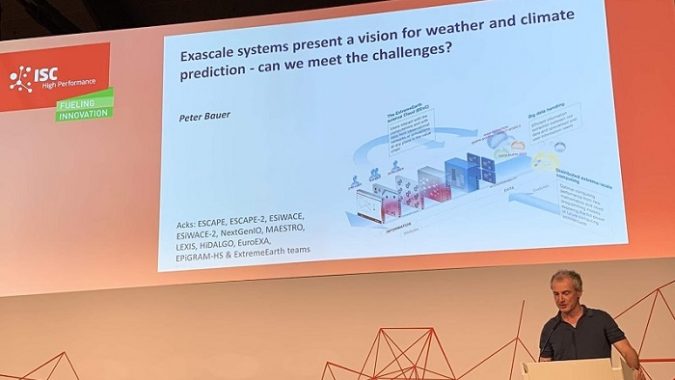At ISC 2019 this week, Peter Bauer – deputy director of research for the European Centre for Medium-Range Weather Forecasts (ECMWF) – outlined an ambitious vision for the future of weather and climate prediction. For Bauer, weather and climate prediction isn’t just an application for exascale — it might be the application: the use case with the greatest challenges – and the greatest potential to showcase the power of exascale computing.

Bauer didn’t linger on the obvious – that now, more than ever, climate and weather prediction have tremendous economic and life-threatening stakes; that predictive failures enable an ongoing and “staggering” loss of life and property. (“So,” Bauer said, “it’s really important.”)
Instead, he pressed on to the core question. “Despite us being high-tech, we have these significant shortcomings. What do we do about it?”
Obstacles
Bauer stressed the scale of the task: weather and climate prediction posed a multi-physics, multi-scale geophysical fluid dynamics problem that needed to incorporate vegetation and a slew of other complicating variables. “Our requirement,” he concluded, “is of the order of a thousand [times] what we are able to do now.” This requirement, he explained, extended to both high-performance computing and data management resources. Weather and climate modeling needed the exascale era.
But this orders-of-magnitude leap in resources is only one of the problems. Due to coding inefficiencies, current weather and climate prediction models only reach about 5 percent efficiency on supercomputers, placing the sector even further away from “true exascale.”
Moreover, the modeling needs don’t stop at accurate atmospheric prediction. “Think of a heat wave or drought that we had last year, for example, in Europe,” Bauer said. “You immediately have to think, if there’s vegetation stress — forest fires; air pollution; impact on human health. So this entire value chain of applications is important as well and needs to be integrated.”
“It’s not just a weather forecast model,” he continued. “It’s really an earth and society forecast model that eventually needs to address these challenges and, again, this has a footprint on technology.”
Homework
Bauer then turned an eye inward toward the weather and climate prediction community. “Have we done our homework?” he asked.
The question, of course, was mostly rhetorical.
Bauer elaborated on the many “inventive” paths the community had taken to maximize returns, despite their resource and coding limitations: parallelizing and vectorizing codes for CPUs; investing in mixed-precision, concurrency, and parallel I/O; dissecting code and analyzing subcomponents; machine learning for surrogate modeling; GPU and FPGA code trials; and more.

Bauer also highlighted how weather and climate prediction researchers had come together as a community, working to ensure that tools, science and algorithms were complementary and engaging with large-scale organizations that had clear and productive goals.
The path forward
To move meaningfully forward, Bauer argued, would require an active, fundamental shift in the weather and climate modeling landscape. “After all the struggles that we have seen over the last decade or so,” he said, “I think we understand that we will never gain effective value from just sitting around and waiting for a solution.”
Bauer presented a solution roadmap in two categories: “algorithms and codes” and “data handling and workflows.” For the most part, the two categories shared solutions – “do less,” “do it cheaper,” “do it on new technology” and “do it yourself.” Bauer broadly recommended streamlining the data workflow using a “generic approach to data structures” to ensure that data was flexible and efficient, as well as using precision, concurrency, and machine learning to reduce resource use.
Regarding precision, Bauer had particularly strong thoughts. “I think single-precision is done,” he said, indicating successfully so. “When I say mixed precision, I will go even harder; you can ask other certain parts of your algorithms that actually favor half-precision or different types of standard-precision standards.”
As for “do it yourself”? “There are no generic solutions,” Bauer explained, “For the part in the middle – the separation of concerns between the top level of algorithmic layers and a diverse range of hardware to which you might want to delegate all your different problems.”
Bauer also highlighted the value of a number of other improvements: code translation for different types of interfaces, data workflow resilience, object-based data storage and more.
In terms of ongoing approaches, Bauer shone a spotlight on ExtremeEarth — a European program designed to “revolutionize Europe’s capability to predict and monitor environmental extremes and their impacts on society,” built on an integration of edge and exascale computing — but lacking sufficient funding.
A pilot demonstration for exascale computing
Bauer presented a question: “exascale systems present a vision for weather and climate prediction – can we meet the challenges?” But then, he said, he started to look at it differently. He posed a new question: “weather and climate prediction present a vision for exascale systems – can we meet the challenges?”
“I think,” Bauer mused, “we’re actually a pilot demonstration for an exascale system.”
“First, we have world science leadership, certainly in Europe – but in other places as well – where we also have technology leadership,” he explained. “It’s obvious, needless to say, that weather and climate have outstanding socioeconomic impacts … and that urgent action is needed. The response to climate change impacts can’t wait for 20 years until we have another generation of supercomputers – we need to find solutions now.”
The exascale goal, Bauer stressed, ties into all of this – from the hardware to the machine learning to the data handling – and the well-integrated weather and climate modeling community was prepared to put in the work. “I think we’re very ready to embrace new technologies,” he said. “I think we’re actually ready to redesign our applications top to bottom.” This way, weather and climate modeling could serve as a pilot that demonstrated the massive value of exascale systems.
“We’re ready,” he said, matter-of-factly. “And weather and climate is the perfect application for exascale.”




























































